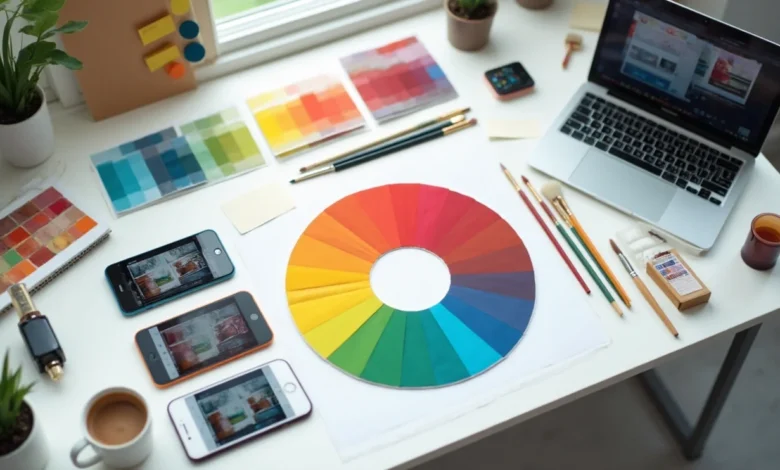How to Choose a Website Color Palette Like Top Designers (Step-by-Step Guide)

Did you know that people make a subconscious judgment about your website within 90 seconds of seeing it, and between 62% and 90% of that assessment is based on the color palette for the website alone?
That’s right – choosing the wrong colors could silently drive visitors away. Color is so powerful that one recent case study found that selecting the right colors can increase conversions by up to 24%! Moreover, 85% of people claimed that color significantly influences what they buy.
These statistics aren’t surprising when you consider that colors do more than just make your site look pretty. You can use target groups to enter and interact with target groups by inducing special emotions and relationships. Furthermore, studies on the psychological effects of colour showed that on average, brand perception can be improved by up to 80%.
Why take risks when website color schemes are so important to online performance? Professional designers discover how to collect visitors, enhance brand identification and implement effective color schemes to increase conversions in this step-by-step guide.
Why Color Matters in Web Design
The strategic use of colour in web design goes far beyond mere aesthetics. Color acts as a powerful psychological tool that shapes user perceptions and interactions in sensible ways on websites.
Improves user experience and readability
Navigation and consumption are significantly improved by the color scheme suitable for your website design. The high color scheme of contrasting pigs promotes reading and understanding text for all visitors, especially those with visually impaired. When the document contrasts the background color, consumers will digest more effectively, with less problems and rejection.
In addition, the implementation of intelligent colors facilitates the direction by focusing on the main aspects such as menu and buttons. This smart application reduces cognitive stress by allowing users to focus naturally in the process of presenting simple and coherent color schemes. Therefore, you will understand how your website works and you have less mental energy to spend more time for your content.
Boosts brand recognition and trust
Colors are very effective in integrating brands in the minds of visitors. Research shows that strategic color consumption can increase brand awareness by up to 80%. This increase in detection is based on the emotional and psychological associations that are naturally invoked.
Consistent use of branding colors on the platform makes users visually familiar with their identity. This consistency creates trust over time – searching for the same colours will repeatedly create trustworthy, particularly valuable in competitive markets.
Influences user behavior and conversions
Color has the biggest impact on your visitor campaigns and purchase decisions. Research shows that 85% of consumers specify color as the main reason to select one product compared to another. This powerful impact extends to transformation-oriented elements such as calls to action buttons.
A notable case study was compared to the green and red buttons on the website. Despite the assumption that Green does better (connected to “GO”), the red button increased the conversion by 21%. This highlights important principles. Colors have psychological weights, but their effectiveness depends heavily on context and implementation.
Strategic choices of warm colors like red and orange create urgency and can be placed immediately. In the meantime, blues and green trust and essential qualities for gentle healthcare financial services and websites can be created.
Understanding Color Theory Basics
To create an effective color palette for website design, you first need to record the basics of color theory. Color theory was originally developed by Isaac Newton in 1666 and provides a framework that leads to designers to make strategic color decisions that users have received well.
Primary, secondary, and tertiary colors
The basis of all color theory begins with primary colors – hue cannot be produced by mixing other colors. Traditionally, these are red, yellow, and blue, but the theory of modern colors of magenta, cyan and yellow is often perceived as more accurate primary colors due to color perception.
Secondary colors emerge when you mix two primary colors in equal amounts:
- Red + Yellow = Orange
- Blue + Yellow = Green
- Red + Blue = Purple
The tertiary color forms the third stage of the color wheel, which is produced by combining the primary color with adjacent secondary colors. This leads to colors such as yellow-green, blue-green, and red-purple. Essentially, these three color category designers offer a wide range of options to work with.
Color wheel and harmony types
The color wheel provides color relationships and makes it an essential tool for creating color schemes for harmonious websites. In addition to basic color relationships, designers use wheels to identify multiple harmony types:
- Monochromatic: Uses variations in lightness and saturation of a single color
- Analogous: Employs colors adjacent to each other on the wheel
- Complementary: Pair of colors from opposite sides of the wheel
- Split-complementary: Uses one color plus two colors adjacent to its complement
- Triadic: Incorporates three colors evenly spaced around the wheel
Warm vs cool colors and their effects
Understanding the temperature of the colour is very important, regardless of the type of harmony you choose. Warm colors (red, orange, yellow) generally remind us of energy, passion and urgency. This means it is ideal for calls and elements that require immediate attention.
Conversely, cool colors (blues, green, purple) convey rest, trust and reliability. This explains why financial institutions and health service providers that Blue often uses for branding, and signal stability.
If you can balance warm and cool colors with the color scheme of your website, you can create emotionally involved designs and guide them to the desired action.
Using Color Psychology to Guide Choices
Color Psychology serves as a powerful tool for web designer Arsenal. If you understand how colors trigger emotional responses, you can create a website color scheme that actually uses your audience to support your business goals.
Common emotional associations with colors
Our emotional responses to colour are no coincidence – they are deeply rooted by evolution, personal experiences and cultural conditioning. Red creates passion, excitement and urgency, which is effectively done in the plot’s actions, but if you go too far you can be overwhelmed. Blue stimulates trust, loyalty, and reliability, explains why it is used frequently on financial institutions and corporate websites.
Green represents growth, harmony and gentle, making it ideal for health, environmental, or finance websites. Yellow indicates optimism and creativity, but it should be used with caution as it can cause eye loads. Lila traditionally conveys luxury, creativity and spirituality, while orange energy is combined with kindness.
Cultural and contextual considerations
In addition to universal associations, the colours of the whole culture have very different meanings. When EuroDisney Purple is strongly introduced into European marketing materials, and we don’t know that Purple represents Catholic Europe’s death and crucifixion, unforgettable misfortune arises. Market research shows Disney has significantly reduced the use of purple in the park and shows advertising material.
Conversely, McDonald’s demonstrates effective intercultural consumption by adapting the distinctive red and simultaneously adjusting the application to various markets. In India, where red symbolizes detection, websites contain saturated red backgrounds rather than just use them as accent colors.
How to align color with brand personality
To create an effective color palette of website designs that correspond to the personality of the brand, first define the brand’s value and the emotions you want to induce. Research shows that strategic color consumption can increase brand awareness by up to 80%.
If the brand emphasizes trust and reliability, the blues can form the main palette. Greens conveys nature for eco-friendly or health-oriented brands. Luxurious and creative brands often benefit from the refined purple association.
Don’t forget that the context is very important – the same color can cause different reactions depending on the application and surrounding elements. Therefore, always test your website’s color palette with a specific audience before making a decision.
Step-by-Step Process to Build a Website Color Palette
Creating an effective color palette for website design doesn’t have to be intimidating. As soon as you understand color theory and psychology, you can follow this step-by-step process to create a professional quality website color scheme.
1. Define your brand tone and audience
First, create a clear explanation of the brand’s value and how you feel about visitors. Consider the preferences and expectations of your target group. Analyze your competitor’s color choices to find differentiation options. Creating at least aspects of your brand identity will give you brainstorming colours that cater to the personality of your business.
2. Choose a primary color
Start with a single basic color that records the essence of your brand. This color controls your website and contains about 60% of the use of that color. For reference color psychology, choose the colour that matches the desired emotional effect. For example, orange conveys enthusiasm and creativity, but trust and stability.
3. Add secondary and accent colors
Add complementary or analog colors as secondary options as soon as primary colors are set. These account for about 30% of the design. Next, select the accent color (about 10% of the palette) to mark important elements such as calls. Consider using color wheel colour harmony to ensure visual aggregation.
4. Test for contrast and accessibility
WCAG 2.0 level AA defines a minimum contrast ratio of 4.5:1 for regular text and a minimum contrast ratio of 3:1 for large text. Use contrast tests to determine whether the combination corresponds to these guidelines. This step ensures readability for all users, including those with visual impairments. Don’t forget that enough contrast improves the normal user experience.
5. Apply the 60/30/10 rule
This interior design principle works perfectly for websites:
- 60% primary color (backgrounds, large areas)
- 30% secondary color (sections, containers)
- 10% accent color (buttons, highlights)
This distribution creates visual balance and directs attention appropriately.
6. Use tools to refine your palette
Professional color tools are used to complete the palette. Adobe Color allows you to extract colors from photographs and combine them harmoniously. colours offer palette generating and testing capabilities. Many solutions provide export options for website deployments, allowing for a more consistent digital presence.
Conclusion
Choosing the right color palette for your website will make a big difference to your online success. In this guide, we investigated how colour affects visitor perception, user behavior, and ultimately affects conversion rates. Most importantly, we saw that the color choices were not arbitrary. Strategic thinking based on the theory of color, psychology and the identity of the brand is required.
The 60/30/10 rules include a practical framework that anyone can apply to create a balanced, professional website color scheme. Understanding the psychology of color also helps you choose the colours that use the target group and effectively communicate your brand’s value. Color accessibility is equally important, as poor contrast eliminates potential customers and undermines the ease of use of the website.
The colour of your website tells the story about your brand before visitors read in one word. Therefore, if it takes time to follow the above step-by-step, dividends will increase brand awareness and improve use. Tools like Adobe Color and Coolors certainly make this process more manageable, but the final decision should always align with specific business goals and audience expectations.
Remember that effective color palettes do not happen by chance – they are caused by intentional design decisions. Start with your brand personality, choose harmonious combinations, test accessibility, and apply colours consistently to your website. Finally, carefully selected color palettes work quietly, creating a positive first impression, building trust and leading visitors to transformation.



